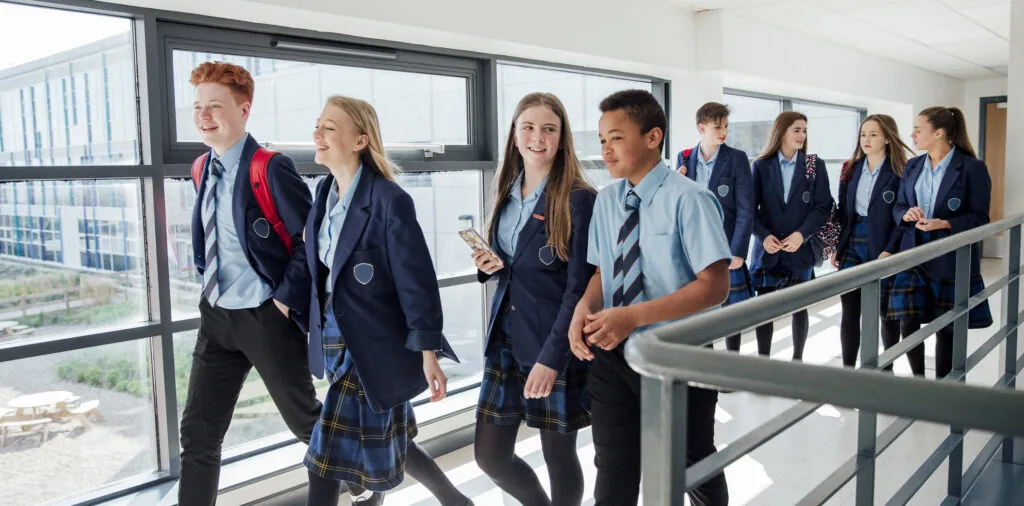
A Student’s Perspective: Should Schools Require Uniforms?
By Vihaan Shah
As we imagine new possibilities for transforming education, who better to ask than a current student?
At 18, Vihaan Shah is a recent high school graduate who aspires to a career in finance and computer science. As a member of the SLO.org Intern Team, he is dedicated to empowering youth through financial literacy.
In the following reflection, Vihaan shares his thoughts on the pros and cons of school uniforms, an educational issue that has long been the subject of debate.
A Student’s Perspective: Should Schools Require Uniforms?
I enjoy picking my own outfits. It is one of the few ways to show some personality before the first bell rings. That is why the idea of wearing the same thing every day has always felt strange to me. My closet might start wondering why I bother keeping it.
Still, uniforms are not just about style, and I can see why the topic sparks debate. For some, they represent order and equality. For others, they feel like a loss of individuality. The truth is, the decision to require uniforms is more complex than it might seem at first glance.
The Case for Uniforms
One of the strongest arguments for uniforms is that they can create a level playing field. In schools where students come from a wide range of economic backgrounds, clothes can become a silent divider. When everyone wears the same outfit, it reduces the pressure to keep up with expensive brands or fast-changing trends. This can help lower the chances of students being judged or excluded based on their appearance.
Uniforms can also help shift the focus back to learning. Without the daily fashion competition, classrooms may feel less distracted. Teachers often say that a more uniform look creates a sense of professionalism and signals that school is a place for focus and effort.
Another benefit is convenience. On a busy school morning, choosing an outfit can be one more stress you don’t need. With uniforms, you simply get dressed and go. This can also save time for parents, especially those with younger children who might resist getting ready.
Finally, uniforms can provide a sense of unity. Just like athletes wear the same jerseys to feel part of a team, students in uniforms may feel a stronger connection to their school community. In certain schools, that pride and sense of belonging can make a significant difference.
The Case Against Uniforms
Of course, there is another side to the story. For many students, clothing is a form of self-expression. The shirt you choose, the sneakers you wear, and even the color combinations you pick all tell a story about who you are. Taking that away can make school feel more rigid than it needs to be.
There is also the cost factor. While some believe uniforms save money, that is not always true. A family might have to buy multiple sets of uniforms and still purchase casual clothes for weekends, sports, and after-school activities. Over time, this can add up.
Comfort is another concern. Not all uniforms are designed with student comfort in mind. Sitting through a seven-hour school day in a stiff collar or hot blazer can be distracting in itself.
And let’s be honest, running to catch the bus is not fun when your outfit was clearly not built for running.
Lastly, uniforms do not guarantee equality. Even if everyone wears the same base outfit, students may still compare accessories, shoes, or other details. In other words, the social pressures that uniforms are meant to solve might shift to other areas.
Teacher Dress Codes
Steve Lear points out that students are not the only ones whose clothing choices matter in school. Teachers also get judged for how they dress, and sometimes that judgment can affect classroom respect.
Research shows that professional attire often signals authority and competence, while casual attire can make teachers seem more approachable. In an informal survey I did with friends, 3 out of 5 said they tended to respect their teachers more when they looked professional, but the same group also admitted they felt more comfortable asking questions when a teacher dressed casually.
One friend explained it this way: “When my teacher wears something more formal, I focus more. But when they dress casually, I feel like I can be myself.”
Casual does not mean unprofessional, and students can usually tell the difference.
These responses suggest that while clothing alone does not define a good teacher, it can set the tone for how students engage in class. A balanced approach, where teachers dress in a way that feels both professional and approachable, may be the best way forward.
My Take
I believe uniforms can be a helpful tool in schools facing specific challenges, such as high levels of bullying over clothing or big gaps in economic background. In those cases, uniforms can help create a fairer environment and take some pressure off students.
However, I do not think uniforms should be required everywhere. A school in a small community with fewer clothing-related issues might be better served by a clear, respectful dress code that still gives students the freedom to make their own clothing choices. If a school does choose to have uniforms, I believe students should have some say in the design and style. They should be affordable, easy to maintain, and comfortable enough to wear all day. Adding small options for personalization, like letting students choose from a few colors or allowing certain accessories, could give the best of both worlds.
At the end of the day, clothing will always be a part of how people express themselves. Freedom of choice does not mean dressing in ways that distract from learning, and students usually understand where that line is. Schools have to balance that need for individuality with the benefits of equality and focus. There may not be a perfect answer, but thoughtful policies can get us closer.


